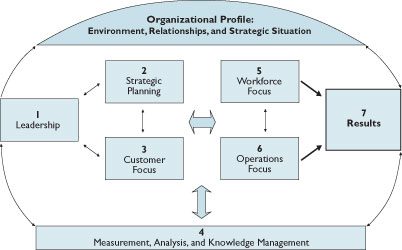Force = Mass x Acceleration

Dr. Harry Hertz, Director Emeritus
Baldrige Performance Excellence Program
January 2012
Force (f) = mass (m) x acceleration (a).
Strategy is critical.
Culture trumps strategy.
Measurement and analysis are critical to strategy execution.
Corporate culture sets the tone for use of data.
Except for the basic physics equation (f=ma), I have read or heard the above statements numerous times over the last year. In this column, I hope to show you that the Baldrige Criteria for Performance Excellence can serve as an integrator that makes sense of these apparently independent or even conflicting statements.
Let me start by suggesting the basic law of physics as a basic premise for your consideration and implementation. I would assert that the force your organization exerts in the marketplace is not merely the sum but, rather, the product of your strategy (mass) times your culture (acceleration). To accomplish your strategy, your culture must be aligned with the strategy; if it is, this alignment greatly accelerates the accomplishment of the strategy. It's not culture or strategy or culture over strategy; it's culture and strategy. I would also assert that the multiplier that causes the effective force in the marketplace is measurement and analysis—the use of the right data as a driver of decisions. If that is not part of your strategy and culture, you don't have a multiplier.
A recent Harvard Business Review blog by Joan Magretta entitled "Jim Collins, Meet Michael Porter" focused my musings on this topic. What particularly struck me about Magretta's post is its contrast with a history of comments and other writings on the primal importance of strategy or, conversely, how culture trumps strategy every time. At the Baldrige Program's annual Quest for Excellence® conference last April, Studer Group CEO Quint Studer shared this statement in a slide presentation: "Culture outperforms strategy every time ... and culture with strategy is unbeatable." With this insight, the distinct statements at the start of this column were beginning to come together for me, though Studer's statement implies an additive function, whereas, to me, culture and strategy together seem much more powerful.
Then I read another HBR blog, by Nilofer Merchant, that asks, "Who cares about the baby?" Merchant writes about the phenomenon in an organization with a strong team culture where the focus on the "handoffs"—that is, where teams each get their piece of the work done and then pass it to the next team—leaves no team taking responsibility for the organization's ultimate success. This approach to work is additive, with each team contributing. Merchant argues that a healthy culture generates something much bigger than the sum of individual contributions and that such a culture involves leverage that accelerates innovation and growth. The analogy would be providing babysitting as one step in preparing a child for a good college, which involves all of one's upbringing and education. Merchant concludes by pointing out that most problems arise in the cracks between divisions or silos in business—in other words, in the "white space." This term and this point struck a chord with me because for years I have been saying that the greatest challenge of being a successful organization today is not managing the seven categories of the Baldrige Criteria (which include Strategic Planning, Workforce Focus, and Leadership) but, rather, managing the white space where the linkages among these categories occur. The whole Baldrige Scoring System and many of the Criteria questions focus on the linkages—alignment and integration. As Merchant points out regarding "white space," a strategy that conflicts with how people behave or make decisions will fail.
Now, let's return to Michael Porter meeting Jim Collins. Porter is a master of strategy. Porter's first test of a good strategy is choosing a distinctive value proposition, and his second test is to tailor your activities to that proposition so that you build a competitive advantage. These are popular Baldrige terms and rely not only on strategy, but also on culture, starting with the vision set and the behaviors demonstrated by senior leaders. Ah culture! Enter Jim Collins, who talks about getting the right people on the bus and the hedgehog concept that builds on doing what you are best at (your competitive advantage) and passionate about. Strategy and culture together drive success. Porter meets Collins.
On a seemingly unrelated note, a new study from MIT Sloan Management Review and IBM finds corporate culture to be key to the use of analytics (data and analysis) in decision making. I have interpreted this finding to conjecture that a corporate culture with analytics and, I would add, a good strategy could multiply the benefits of a high-performing culture and a clear strategy to become a potent force in the marketplace. This is where that old law of physics comes to mind for me: Force (in the marketplace, or success) is the product of mass (your strategy) times acceleration (your integrated culture). And the multiplier is management by fact (data and analysis).
This is all manifest in the Baldrige Criteria. It starts at the very beginning (as Julie Andrews sang) with the Organizational Profile. Section P.1 is about your organizational characteristics. This really is a description of your culture and your "hedgehog," your core competencies, and what you do to ensure success. Section P.2 is about your strategic situation. This is a description of your competitive environment, including your strategic advantages and challenges, and changes that could affect your competitive environment. We say that your first Baldrige assessment can be as simple as answering only the questions in the Organizational Profile. Tell us about your culture and your strategy and how they relate to your mission and core competencies. At the base of the sandwich-like Baldrige Criteria framework, the multiplier (data and analysis) is the other piece of bread that holds the management system together. Without either the top or bottom pieces of bread, the sandwich falls apart.
As you look at the Baldrige framework, consider what force your enterprise is exerting in your marketplace. Are your culture and strategy data-driven and integrated to achieve that multiplicative effect? Have you got both pieces of bread? If not, why not make this a New Year's resolution you will keep? Happy New Year and healthy eating!
Resources
Baldrige Excellence Framework
Baldrige Excellence Builder
Blogrige
News
Archived Columns
You need to have Acrobat Reader installed on your computer to view the PDF file. If you do not have Acrobat Reader installed on your computer, download the program at http://get.adobe.com/reader. People with visual disabilities can download tools and information at http://access.adobe.com to help make Adobe PDF files accessible.
Contacts
-
Baldrige Customer Service(301) 975-2036NIST/BPEP
100 Bureau Drive, M/S 1020
Gaithersburg, MD 20899-1020

